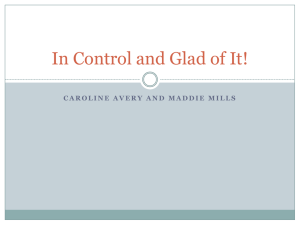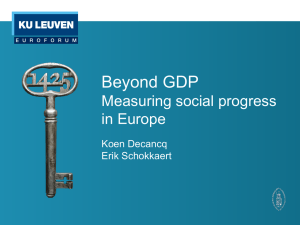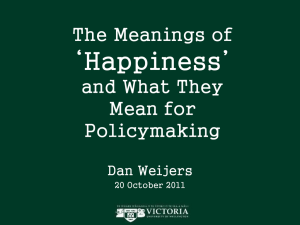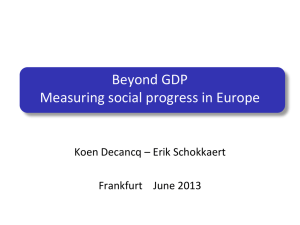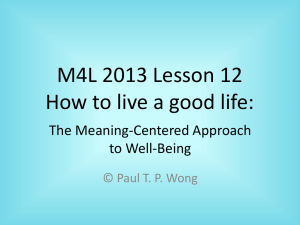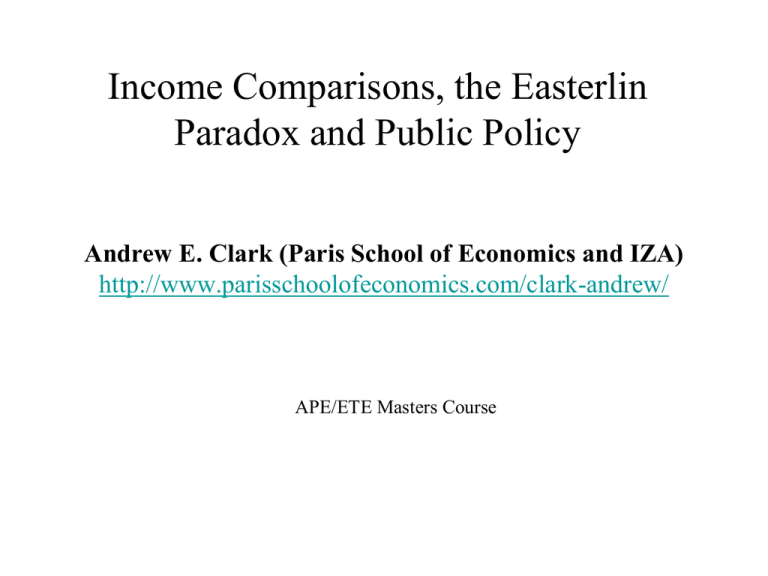
Income Comparisons, the Easterlin
Paradox and Public Policy
Andrew E. Clark (Paris School of Economics and IZA)
http://www.parisschoolofeconomics.com/clark-andrew/
APE/ETE Masters Course
You might think that money might help us to
achieve the variety of different kinds of wellbeing that have been put forward as important
in the literature.
Being poor certainly prevents us from doing
many things that we would like to do.
If you don’t believe me, then try it…
But in addition to wishful thinking, what does the
data say?
One of the first, and most original, researchers in this
area is Dick Easterlin (University of Southern
California).
He asked two questions:
1) Are richer individuals/countries happier than
poorer individuals/countries?
2) As countries get richer, does everyone become
happier?
We might expect the answer to these two questions to be
the same.
I here present some of the results from:
Easterlin, R. A. (2005). “Diminishing Marginal
Utility of Income? Caveat Emptor”. Social
Indicators Research. pp. 243-255.
This specifically deals with the case of Japan.
Japan was a poor country in the 1950s/early
1960s, but then experienced unprecedented
growth.
Fact 1. Richer countries are happier countries.
The blue lines show the
estimated relationship
between income and
happiness
Japan
Japan was in the middle of the income distribution in the early 1960s, and had
a middling level of happiness
So what happened as Japan became richer?
Look at annual indices (1962=100) of life
satisfaction and real GNP per capita for Japan,
1958-1987
Between 1962 and 1987 Japan experienced
unprecedented economic growth, with GNP
per capita (in real terms)rising 3.5-fold:
growing from 22 to 77 percent of the United
States level in 1962
We might then imagine that Japan would follow
the blue lines above: as Japan became richer, it
would become happier.
In fact, happiness remained constant despite
Japan’s remarkable economic growth
What “should” have happened
What did happen
Are the Japanese strange?
40000
3
2.5
Average Happiness
30000
2
20000
1.5
1
Happiness
Real Income Per Capita
10000
0.5
0
0
1973
1977
1981
1985
1989
1993
1998
Real Income Per Capita (2000 US$)
Not necessarily: the same thing can be observed in 30 years of American GSS
data
2003
Year
This is the Easterlin Paradox. Richer individuals are happier, but as
countries become richer over time they do not become happier.
The challenge to social science is to try to explain why.
This finding has generated a considerable amount of
controversy: it just MUST be wrong
One point to remember is that the Easterlin Paradox is a
statement of why continuous GDP growth may not
increase social welfare in the long-run.
It is not a theory of recessions not mattering: we
shouldn’t be surprised if life satisfaction and the
economic cycle are correlated in the short run
After all, unemployment is a robust significant indicator
of individual subjective well-being (the blips in the US
happiness line correspond to the business cycle)
Recent work has considered (and reconsidered) time–
series evidence suggesting that the average well-being
lines over time above are “really” flat
One well-known contribution is Stevenson and Wolfers
(2008)
- There are issues with data comparability over time in
Japan: the questions changed over time
Recent work has considered (and reconsidered) time–
series evidence suggesting that the average well-being
lines over time above are “really” flat
- SW agree that life satisfaction in the USA follows the
business cycle. But also that there is no trend in the
GSS data.
Recent work has considered (and reconsidered) time–
series evidence suggesting that the average well-being
lines over time above are “really” flat
- There is a positive trend in both happiness and life
satisfaction scores in the World Values Survey.
- Easterlin points out that the trend in WVS happiness
scores came from a change in the way the happiness
question was administered.
- And one of the two positive life satisfaction slopes is
entirely driven by the recovery of transition countries.
- While the other relies on two data points (and so
wouldn’t survive a jackknife analysis)
United Kingdom (BHPS): Real GDP per capita and life satisfaction
1996 - 2008
West Germany (SOEP): Real GDP per capita and life satisfaction
1984 - 2010
Australia (HILDA): Real GDP per capita and life satisfaction
2001 - 2009
Life Satisfaction in Five European Countries, (World Database of Happiness)
1973-2004
Average Life Satisfaction
4
3.5
3
2.5
2
1.5
UK
1
France
Germany
Italy
Netherlands
0.5
0
1973
1977
1980
1983
1986
Year
1988
1990
1993
1996
2000
2004
It is easy to lose the will to live when reading the attacks
and counter-attacks.
There are fundamental issues with the analysis of timeseries happiness data.
It is easy to lose the will to live when reading the attacks
and counter-attacks.
There are fundamental issues with the analysis of timeseries happiness data.
1) It is time-series happiness data. So we are making
strong statements off of differences in slopes estimated
using 20, or 10, or 4 observations.
It is easy to lose the will to live when reading the attacks
and counter-attacks.
There are fundamental issues with the analysis of timeseries happiness data.
1) It is time-series happiness data. So we are making
strong statements off of differences in slopes
estimated using 20, or 10, or 4 observations.
2) There are never any control variables (age, sex,
education, country of birth, urban/rural, labour force
status, marital status, and so on): how much of this is
a composition effect?
1) It is time-series happiness data. So we are making
strong statements off of differences in slopes
estimated using 20, or 10, or 4 observations.
2) There are never any control variables (age, sex,
education, country of birth, urban/rural, labour force
status, marital status, and so on): how much of this is
a composition effect?
3) There are never any macro control variables
It is easy to imagine macro “omitted variables” which
may obscure the effect of income: inequality, crime,
pollution etc.
Perhaps we should stop looking at time series
We often appeal to the notion of relative utility, whereby
W = W(y, y*, …) to explain the Easterlin Paradox.
So let’s turn the question around: if we find strong and
consistent evidence of a role of some benchmark or
comparison income in individual well-being, then the
Easterlin Paradox must at least partly hold:
- Then the time-series and cross-section relationships
between subjective well-being and income cannot be the
same
BROAD IDEA
A common idea across the Social Sciences: well-being or utility
depends on some kind of comparison process of what you have
relative to a reference level.
Comparisons can be over “things” or over money.
An example. Two people, A and B, who live next to each other,
both like cars.
WA = W(CarA,.....)
WB = W(CarB,.....)
Where “W” is the individual’s well-being function.
Key question: is A more likely to buy a new car if B
buys a new one?
Standard economic theory:
Comparisons/relative utility:
No.
Yes.
If the answer is “yes”, then we could write A’s
“happiness function” as WA = W(CarA/CarB,....):
how good is my car relative to my neighbour’s?
This might sound like a ridiculous proposition.
It isn’t, at least not in the Netherlands.
Kuhn, P., Kooreman, P., Soetevent, A., and Kapteyn, A.
(2011). "The Effects of Lottery Prizes on Winners
and their Neighbors: Evidence from the Dutch
Postcode Lottery". American Economic Review,
101, 2226-2247.
Each week, the Dutch Postcode Lottery (PCL) randomly
selects a postal code, and distributes cash and a new
BMW to lottery participants in that code.
There are 430 000 postodes in the Netherlands. An
average postcode includes around 20 households.
A winning participant wins €12,500 per ticket. In
addition, one participating household in the winning
postcode receives a new BMW.
Households in postcodes surveyed six months after the
prize was won.
PCL nonparticipants who live next door to
winners have significantly higher levels of car
consumption than other nonparticipants
(sig. levels are all relative to column 2, the non-participants in
non-winning PCs)
Applied to Income, instead of Cars:
Income and Subjective Well-Being (SWB)
Standard model:
Comparisons:
W = W(y, ....)
W = W(y/y*, ....)
This is analogous to the car example.
The variable y* is “comparison income”: the income to
which we compare/income of the reference group.
I mostly consider evidence here resulting from direct
measurement of “W”, via job satisfaction, life
satisfaction, mental stress etc.
Validated by physiological/neurological studies, thirdparty raters, and (most importantly) future
behaviours such as divorce, unemployment
duration, quitting one’s job, and morbidity and
mortality.
There is nothing to stop us looking at behaviours too: I
think of the analysis of behaviour and proxy
measures of utility as complements, not substitutes.
To whom do we compare?
Peer group/people like me
Others in the same household
Spouse/partner
Myself in the past
Friends
Neighbours
Work colleagues
“Expectations”
We typically know nothing about the reference
group. Wave 3 of the European Social Survey
(22 countries) helps here.
Table1. “How important is it to you to compare your income with other people’s incomes?”
Not at all important
1
2
3
4
5
Very important
23.80
17.01
13.86
16.95
13.52
9.42
5.44
he
rla
Sw nds
ite
rla
n
Fi d
nl
a
Ge nd
rm
an
Au y
str
Un
Be ia
ite
lg
d
i
Ki um
ng
do
Po m
rtu
ga
Ir e l
l
Da and
ne
m
a
No r k
rw
a
Bu y
lg
ar
ia
Fr
an
Hu ce
ng
a
Sw ry
ed
Sl en
ov
en
ia
Ru
ss
i
Es a
to
ni
a
Po
lan
Uk d
ra
in
e
Sp
a
Sl in
ov
ak
ia
Ne
t
2.9
2.7
2.5
2.3
2.1
1.9
1.7
1.5
Work colleagues
Family members
Friends
Others
Don't compare
Observations
6 159
929
2 382
1 192
5 185
Weighted %
38.93
6.03
14.94
7.39
32.72
Income and
comparison
intensity are
negatively
correlated, both
within and between
countries
Work colleagues
Family members
Friends
Others
Don't compare
Observations
6 159
929
2 382
1 192
5 185
Weighted %
38.93
6.03
14.94
7.39
32.72
Mostly we just impose a reference group, such as people
like me, neighbours or family.
I use the British Household Panel Study (BHPS) to look
at the relationship between job satisfaction and
labour income. Main findings:
There is some evidence that job satisfaction is an
increasing function of income. However, job
satisfaction falls as others’ income rises. This holds
for:
The income of “people like you” (same
characteristics, same type of job).
Partner’s income.
The income of other adults in the same household.
The income that you yourself earned in the same job
one year ago.
Clark and Oswald (1996). BHPS
Data on 5000 Employees
Log income (y)
Log comparison income (y*)
-0.02
(0.039)
---
Log NES comparison income (y**) ---
0.11
(0.050)
-0.20
(0.062)
---
-0.001
(0.04)
---0.26
(0.073)
“Comparison Income” predicted from a Mincer Earnings equation (note:
requires exclusion restrictions to avoid multicollinearity);
“NES comparison income” matched in from another data set by hours of work,
and thus avoids identification problems (but assumes reference group
defined by hours of work).
Clark (1996). BHPS Data on 5000
Employees
Log hourly pay: ln(HPi)
Log Hours
Log spouse's
hourly pay: (ln(HPs))
Dummy: HPi > HPs
Log spouse's hourly pay
(when HPs > HPi)
0.111
(0.060)
-0.251
(0.061)
-0.121
(0.044)
-----
0.039
(0.068)
-0.246
(0.061)
-0.056
(0.052)
0.171
(0.074)
---
0.060
(0.066)
-0.250
(0.061)
-0.047
(0.059)
---0.069
(0.037)
Estimated only on couples where both partners are in work. Includes other standard
control variables.
Comparisons to the past: Clark
(1999). BHPS Data
Log current monthly pay
0.086
(0.071)
Log current monthly hours -0.081
(0.215)
Log monthly pay one year ago ..
% Change in pay/100
..
0.486
(0.166)
-0.428
(0.295)
-0.442
(0.163)
0.523
(0.288)
..
% Change in hours/100
..
..
% Change in hourly wage/100 ..
..
Log monthly hours one year ago..
0.042
(0.072)
0.114
(0.236)
..
0.038
(0.072)
0.067
(0.219)
..
..
..
0.439
(0.146)
-0.518
(0.285)
..
..
..
0.450
(0.126)
Two waves only. Estimated on individuals who did not change job or get promoted
between the two waves.
Therefore, when we look at the effect of own pay and
others’ pay on satisfaction, we find the following kind
of stylised relationships:
Satisfaction
Income DOES bring happiness... As long as you get it
and no-one else does
Own pay (y), holding y* constant
Satisfaction
Others’ pay (y*), holding y constant
Satisfaction
Pay rises for everybody (y/y* constant)
Others have replicated these broad
findings with work on life satisfaction
and local area average incomes: Ferrer-iCarbonell for Germany, and Luttmer for
the US.
There are three reasons to wonder
whether these comparison income results
are entirely right:
• The Danish
• Tunnels
• Altruism
1) This is Denmark
• From January 1, 2007, Denmark has been
split up into five Regions: two in Zealand,
two in Jutland, and one covering Funen
and Southern Jutland.
• Previous to this, Denmark was split up into
15 counties, and 273 municipalities.
• We use new geo-referenced data, based
on a geographical grid of size 100*100
meters (i.e. 10 000 square meters, or a
hectare) covering the entire country.
• Some of these grid cells are uninhabited, others are only
very thinly inhabited: around two-thirds of inhabited
hectare cells contain under five households.
• Data confidentiality: Statistics Denmark aggregates to
produce clusters of neighbouring hectare cells with a
minimum of 150 (600) households.
• Adjusted by Damm and Schultz-Nielsen (2008) to
produce a classification
Constant over time
Marked out by physical barriers (roads, rivers)
Compact
Contiguous
Homogenous in terms of type and ownership of housing
(don’t mix flats and houses).
Figure 1
Small neighbourhoods in the area of Taastrupgård, Høje Tåstrup
Source: Damm and Schultz-Nielsen (2008).
Economic Satisfaction, Income and Rank within Small
Neighbourhoods: Panel Results
Ln(HH income)
Ln(median grid HH income)
Ln(median municipality HH income)
Relative rank in small grid
See Neighbours Often
Single
Health problems dummy
Age dummies (9)
Education dummies (6)
Socio-Economic Group dummies (3)
No. and Ages of children dummies (5)
No. Years in Grid dummies (5)
Regional dummies (13)
Year dummies (8)
Observations
Baseline
Baseline and
Municipality
Baseline and
Rank
0.390**
(0.021)
0.228**
(0.052)
---------0.019
(0.016)
-0.057*
(0.027)
-0.023
(0.017)
0.390**
(0.021)
0.236**
(0.055)
-0.062
(0.156)
-----0.019
(0.016)
-0.057*
(0.027)
-0.023
(0.017)
0.070*
(0.028)
0.634**
(0.057)
----1.124**
(0.068)
-0.016
(0.016)
0.025
(0.028)
-0.023
(0.017)
Yes
Yes
Yes
Yes
Yes
Yes
Yes
Yes
Yes
Yes
Yes
Yes
Yes
Yes
Yes
Yes
Yes
Yes
Yes
Yes
Yes
33 870
33 870
33 870
So individuals like living with richer (very close)
neighbours. This probably reflects local public
goods or social capital. In this sense, were we
able to hold public goods and social capital
constant, then I would expect the sign on
neighbours’ income to become negative.
This is what column 3 effectively does. It holds
average neighbourhood income constant, and
looks at rank effects. Consistent with previous
work, this is positive.
People like having rich neighbours…and being on
top of the pile.
2) Tunnels
Senik, C. (2004). "When Information Dominates Comparison: A Panel
Data Analysis Using Russian Subjective Data.". Journal of Public
Economics, 88, 2099-2123.
Clark, A.E., Kristensen, N., and Westergård-Nielsen, N. (2009). "Job
Satisfaction and Co-worker Wages: Status or Signal?". Economic
Journal, 119, 430-447.
A smaller number of recent papers have uncovered empirical results
where some measure of individual well-being is positively correlated
with reference group income or earnings: the more others earn, the
happier I am.
This finding has been interpreted as demonstrating Hirschman’s tunnel
effect (Hirschman and Rothschild, 1973): while others’ good fortune
might make me jealous, it may also provide information about my
own future prospects.
The distinction between status and signal depends on how likely you are
to end up in the future with your reference group’s current income.
Senik considers a very unstable labour market (Russia); Clark et al
examine the average earnings of other workers within the same firm.
But how pervasive are signal effects in general?
3) Altruism
Dunn, E., Aknin, L., and Norton, M. (2008). "Spending Money on
Others Promotes Happiness". Science, 319, 1687-1688.
• Individuals are forced to be generous: they are given an
envelope with either $5 or $20 to spend that day.
• Half are told to spend the money on themselves, and the other
half on someone else.
• Spending money on others produces greater happiness than
spending money on oneself.
People do not realise this ex ante.
Does this challenge the hypothesis that well-being is relative in
income?
Not necessarily. We can imagine that people’s well-being is
affected by both envy and altruism. The objects of these two
feelings are probably not the same. When individuals buy gifts,
they may not buy gifts for those in their reference group.
The results with respect to past income are interesting: the more
you earned in the past, the more you need to earn now in order
to be just as satisfied: wages are habit-forming.
Job satisfaction
This implies that someone who receives a pay rise will have job
satisfaction over time as follows:
Time
Pay rises are good at the time, but then you get used to
them. How can a firm keep its workers satisfied then?
By starting them at a relatively low wage and giving
them constant pay rises: profile C.
Pay
C
B
A
Time
Even a small amount of comparison to the past produces
sharply-rising consumption profiles.
Conclusion:
There are strong comparison effects both spatially (between
groups) and over time with respect to income.
These two phenomena can explain the Easterlin paradox
40000
3
2.5
Average Happiness
30000
2
20000
1.5
1
Happiness
Real Income Per Capita
10000
0.5
0
0
1973
1977
1981
1985
1989
Year
1993
1998
2003
Real Income Per Capita (2000 US$)
FIGURE 1: Happiness and Real Income Per Capita in the US, 1973-2004
Subjective Well-Being Measures are not the only possible way of
showing comparison effects.
1) The Leyden approach. Invert the question: Who needs more
money to have a good life?
Initiated by Bernard Van Praag.
Ask individuals to assign income levels (per period) to six or nine
different verbal labels (such as "excellent“,"sufficient" and
"bad").
Van Praag can then estimate for each individual a
lognormal “Welfare Function of Income” (the jump in
income required to go from one label to another
becomes increasingly large).
The resulting individual estimated means () and
variances () – there is one curve for each person –
were then used as dependent variables in regressions
to show which types of individuals require a higher
level of income to be satisfied, and which individuals
have valuations that are more sensitive to changes in
income.
Those with higher reference group income, and who had
earned more in the past, had higher values of .
Those with higher values of μ use lower verbal well-being labels at any given
level of income
2) Ask people. Preference for rising income
profiles, and preferences for lower absolute
incomes:
• A: Your current yearly income is $50,000;
others earn $25,000.
• B: Your current yearly income is $100,000;
others earn $200,000.
Individuals have a marked preference for A over
B.
Positionality differs according to the domain. In
Alpizar et al. (2005) this is stronger for cars and
housing, and weaker for vacations and
insurance.
3) Experimental.
a) Ultimatum game: responders frequently
rejecting offers that are under 25% of the
total sum; as such the the vast majority of
offers are between 40% and 50% of the
sum.
b) Dictator game: non-strategic. The survey
of 616 such experiments in Engel (2011)
concludes that dictators give on average
28.35% of the sum of money to be
divided.
c) Zizzo and Oswald (2001) report the results of
an experiment whereby subjects can pay to
burn each other’s money. A majority of
subjects chose to do so, even though it costs
them real earnings. The average subject had
half of her earnings burnt, and richer subjects
were burnt more often.
d) Psychological experiments. Danny
Kahneman’s hand in bucket of water
experiments show that the change in pain
predicts overall evaluation (rather than the
level).
e) McBride (2010) introduces a novel way of calculating
aspirations directly in a matching pennies game, where
individuals play against computers.
The computer chooses heads or tails according to (known)
probability distributions (for example 80% heads, 20% tails).
After each round of playing, individuals report their satisfaction
with the outcome.
Introduces social comparisons in some of the treatments (by telling
the individual the outcomes of the other players).
Aspiration effect identified by varying the heads and tails
probabilities played by the computer. Each subject has five
pennies to play. When paired with a 80% heads, 20% tails
computer, the best strategy is to always play heads, which gives
an expected payoff of four pennies. When paired with a 65%
heads, 35% tails computer, the best strategy is still to always
play heads, but now the expected payoff is only 3.25 pennies.
Results: satisfaction is
i) higher the more one wins
ii) lower the more others win
iii) lower the higher was the aspiration level.
4) Natural Experiments
Card et al. (2012): the revelation of information on
others' earnings.
The natural experiment here is a court decision that
made the salary of any California state employee public
knowledge.
A local newspaper set up a website making it easy to
find this information.
Following this website launch, Card et al. informed a
random subset of employees at three UC campuses
about the site.
Some days later, all employees on the three
campuses were surveyed.
Compare the treatment group (informed
about the website) to others to reveal the
impact of information on others' salaries.
The reference group was defined here as
co-workers in the same occupation group
(faculty vs. staff) and administrative unit in
the university.
The survey found lower job satisfaction for
those with pay below the reference group
median and a greater intention to look for a
new job.
The effect on both for those who were
relatively well-paid was insignificant.
There is some evidence of an actual
quitting effect on those who were found to
be in the bottom earnings quartile in the
reference group.
5) Neuro. Fließbach, K., Weber, B., Trautner, P., Dohmen, T., Sunde, U.,
Elger, C., & Falk, A. (2007). "Social comparison affects reward-related brain
activity in the human ventral striatum". Science, 318, 1305-1308.
Payoffs vary according to whether the individual gets the task right, and also randomly
when the task is correct
Brain activity measured via BOLD in various
voxels.
Particular attention paid to the ventral striatum:
the “neural circuitry of reward”
This kind of striatal activity has been shown to
predict both hedonic outcomes (subjective
well-being) and physiological outcomes
(cortisol output: the body’s response to stress)
Brain activation depends on relative income: compare C6, C8 and C11 (where the
individual receives 60 Euros), and C7 to C9.
What Changes in Micro Analysis if
Utility is Relative?
A lot….
1) Labour supply is determined by the income: leisure
trade-off. Under relative utility, higher income may
not be associated with lower marginal utility (latter
is also determined by y*, and higher levels of y*
increase the marginal utility of own income).
There is a positive cross-partial between y and y*…
Possibility of everyone working too much (with
associated tax implications).
2) A taste for rising income profiles can explain why
wages rise faster than productivity. Also explains
wage compression, and wage secrecy. And optimal
rising consumption profiles.
3) Poverty: defined in terms of income or utility? There
is no longer a monotonic relationship between the two
4) Individuals accumulate wealth over their lifetime, and
productivity generally increases: reference income
when ‘old’ is always higher than that when ‘young’.
Savings may be too low: individuals will not postpone
consumption to the future as future general
consumption levels then will likely be higher due to
productivity growth. This is a large (theoretical)
literature: see Section 5.6 of Clark et al. Journal of
Economic Literature (2008).
5) Conspicuous consumption introduces
externalities between individuals, which should
be corrected by a tax. Taxing luxury cars will
make no difference to utility if they are only
consumed for rank reasons.
6) Migration. Now no longer only for income,
but also for relative standing reasons. Anti
brain-drain conclusion (Mexican Doctors).
7) Relative utility might imply following
behaviour… or it might not. Consider an
additive comparisons model:
8) Worker behaviour, such as quitting and effort
(productivity) will depend not only on own
income, but also income of others. See Clark,
A.E., Masclet, D., and Villeval, M.-C. (2010).
"Effort and Comparison Income". Industrial
and Labor Relations Review, 63, 407-426.
The rank-dependence of effort (Random-effect Tobit model)
Macro Implication.
As a result of the Easterlin Paradox:
“Money/possessions aren’t making us any happier: we
should spend our time concentrating on X instead”
Candidates for X:
A (good) job
Marriage/Family
Social Activities
Freedom/Democracy
Health
Religion
But what if we found the same phenomena of adaptation
and comparisons there too? This is only rarely tested.
Public Policy
Important to note that policy can’t do anything about
some of the things we know are important from 20
years of subjective well-being research.
Gender
Women often report higher life satisfaction scores than
men...
but also higher psychological stress scores
Nolen-Hoeksema, S., and Rusting, C.L. (1999). "Gender
differences in well-being". In D. Kahneman, E.
Diener, and N. Schwartz (Eds.), Well-being: The
foundations of hedonic psychology. New York: Russell
Sage Foundation.
Policy can’t do anything about some of the things we
know are important from 20 years of subjective wellbeing research.
Age
6.7
(mean) satlife
7.25
well-being by age and sex
20
40
60
Age of Individual
female
male
80
The “happiness smile” (or grimace) is almost
ubiquitous. But we still are not sure what is behind it
Policy can’t do anything about some of the things we
know are important from 20 years of subjective wellbeing research.
Country
The happiest country in the world is …
Australia!!
Or Denmark, or Nigeria.
Policy question: How do we make the French Australian?
Well-being and the Labour Market
They’re right! Unemployment really is important.....
ECHP: Satisfaction Scale 1-6. 500 000 individuals.
ECHP: Labour Force Status and
Life Satisfaction
4.5
4
3.5
Life
Satisfaction
3
2.5
2
Self-Employed
Employed
Unemployed
Labour Force Status
But do you adapt to it, and is it relative?
NLF
Main results:
The psychological impact of unemployment is lower
When the regional unemployment rate is higher (estimated: no
impact for regional unemployment of 20-25%).
When there is more unemployment in the household
(estimated: no impact if all other adults in the household are
unemployed too).
When the individual’s past unemployment is greater
(estimated: no impact if the individual has been unemployed
for 2 out of the past 3 years).
All of these effects are far stronger for men, especially prime-age
men (16-50), than for women.
Social Comparisons with respect to Unemployment?
EA95
3
NW96
EM
91
2
GHQDifference
RS91 EAE
M
96
92
SW92
EM
93WA
9H
393
Y
WM
95
9491
NW
95
RS95 SW
SW
SW
93
EA94 WA96
GL91
RS96
RS93
W
M
91NW94
Y9
H
9
7A9W
RS
2
W
7 A95WA
91
EA91
YH92
SS
C9
2
NW97 RS94
CS
9N
1
W
91
EM
95YH96
C
94
GL96
EA97
NT96
NT91
NW93
SC96
YH94 WM
92
SC97
GL92
SW96
WM
93
GL95
G
L
9
7
EM
97
YE
HM
99
52
S
C
9
3
NW92
EA
WM
97
99
53
SW97
NT92
SW9S
5C
E
M
94
RS97
1
W
92
T97
YH9
1AN
GL93
GL94
0
EA96
WM
96
94
WA94WM
NT93
NT95
NT94
-1
5
10
Regional Unemployment Rate
15
The well-being gap between employees and the unemployed is
smaller in regions with greater unemployment.
Social Comparisons with respect to Unemployment?
70
60.2
60
57.9
57.6
55.6
50
40
38.4
40
30.9
30.8
30
20
10
U
ar
tn
er
.P
U
U
.P
tn
er
ar
tn
er
E
U
E
E.
Pa
r
tn
er
E.
Pa
r
Re
g=
10
%
U
.U
Re
g=
5%
U
.U
Re
g=
10
%
E.
U
E.
U
Re
g=
5%
0
Unemployment hurts less when I share it with other household members
But there is little adaptation to unemployment
Unemployment starts bad, and stays bad
We get used to marriage
And we get used to divorce
Even widowhood is worse at the beginning than afterwards
And we can’t even count on our children
Social Comparisons with respect to Divorce?
Can these two possibly be related?
Own divorce hurts less in a high-divorce region
The estimated effect of divorce is zero in a region with a 25%
divorce rate.
Is this a “plenty more fish in the sea” effect?
Not only: the largest effect is from the regional
percentage of divorced men on male divorce
Adaptation to Poverty
We may adapt to income in general, but
what about adaptation to poverty as a
specific low-income state?
0
0-1
1-2
2-3
3-4
4-5
-0.1
-0.2
-0.3
-0.4
Whole Sample
Men
Poverty starts bad and stays bad
Women
5+
Social Comparisons and Social Capital?
Research on BHPS data shows that:
Individuals are happier when their levels of social
capital (measured by social activities) are higher
(but beware of causality)
1) Individuals are also happier when they live with
other household members who are active
socially
2) But, given own social capital and others’ social
capital, there is a happiness boost from being the
most active individual in the household.
Well-Being and Others’ Social Capital: WVS Evidence
Spillovers are defined at the regional (NUTS2) level. We
drop regions with fewer than 50 observations. Others’
social capital measured by the regional median level
Own SK Activity
0.075**
(.011)
Regional SK Activity (median) -0.098+
(.059)
It is still good to be active oneself: but well-being is higher
when others’ social activity is lower, as if there were
comparisons in social capital. This can be seen in the
coefficient on the continuous measure of others’ median
social capital above.
Well-Being and Others’ Social Capital: ESS Evidence
Meet Friends
Regional Average
Meet Friends
Observations
Log likelihood
All
0.156**
(0.004)
All
0.158**
(0.004)
Women
0.167**
(0.006)
Men
0.145**
(0.006)
-0.164**
-0.210**
-0.112*
(0.037)
(0.050)
86555
86555
45700
-164054.3 -164044.7 -86998.9
(0.057)
40855
-76927.6
Social Comparisons and Health?
Work on European data has shown that :
1) My own health problems have less effect on my
own well-being when the problems are shared
by others in the same household.
2) Individuals feel less overweight as the average
weight in the region rises
3) Within the household, couples where both are
obese have similar mental stress levels to
couples where neither is obese
Women like their partner to have
the same BMI as they do (life
satisfaction in the BHPS)
And… so do men
Well-Being and BMI: Household Results.
BHPS Wave 14
GHQ
Obese
-0.101**
(0.031)
-0.092*
(0.039)
-0.035
(0.039)
-0.162**
(0.045)
-0.104*
(0.045)
0.263**
(0.099)
10648
6035
6035
Spouse Obese
Both Obese
Observations
Note: Plus controls for Age, Sex, Education, Marital Status,
Labour Force Status, and Income.
And for those of you who like it semiparametrically, the “Happiness Hills”
The hill peaks are on a 45-degree line: your own
weight doesn’t matter if it matches your partner’s
Social Comparisons and Religion?
Recent work on European Social Survey Data
shows that:
Religious individuals are happier when they live in
religious regions
1) But atheists are happier when they live in
religious regions too
2) Catholics get a happiness boost from being in a
Catholic majority region
The religious “spillovers” are mostly positive
Spillover effects of specific religious denominations:
Life satisfaction regressions
Spillover effects of specific religious denominations:
Life satisfaction regressions
The religious like being with other religious; they don’t like
being with atheists.
Atheists are more satisfied when they live in more religious
regions too.
Atheists don’t like living with other atheists either.
Conclusions
1) Let’s switch from the extensive to the intensive margin.
How much does the EP hold?
2) Are comparisons cardinal or ordinal? If the latter, then
the EP holds fully
3) Who is in the reference group?
4) Is this a rich country result?
5) What is well-being anyway
- Life satisfaction?
- Happiness?
- Psychological functioning?
- Eudaimonia?
We need to find domains of life that are non-rival to which we do
not adapt…
A Summary
Horizontal
Comparisons
(Status)
Intertemporal
Comparisons
(Adaptation)
Income
Yes
Yes
Unemployment
Yes (but small)
No
Poverty
?
No
Marriage/Divorce
Yes
Yes
Health
Perhaps?
Partial?
Social Activities
Perhaps?
No?
Freedom
?
?
Religion
Perhaps?
?
Is everything really lost for GDP per capita?
Almost all discussion in the literature has looked
at mean happiness.
We might not be so utilitarian though, in that we
care about the distribution of happiness too.
Could give more weight to those at the bottom of
the well-being distribution: misery-aversion.
Here GDP per capita does seem to play a role
Happiness inequality and GDP per capita across countries, WVS
Last available year (2000s)
Happiness inequality within Country over Time in Growing Countries,
Selected Western countries (WVS)
Happiness inequality Over Time with Some periods of Negative or Zero
Growth (WVS)
Happiness inequality Over Time during Periods of Decreasing GDP
(WVS)
Single Country Results
United Kingdom (BHPS)
West Germany (SOEP)
Single Country Results
Australia (HILDA)
United States (GSS)
Income growth reduces happiness inequality, as do “social
programmes”; income inequality increases happiness inequality


